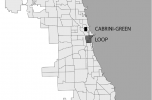The Fate of a Housing Estate No. 6. Careful Orientation in the 21st Century
Cabrini-Green, Chicago, construction (1941–1962) and demolition (1994–2011)
Text: Melinda Benkő
Thinking of modern housing estates, only a few people recall the Unites States of America, as the general image associated with this phrase is that of detached houses on the outskirts of cities or privately owned apartments. Meanwhile, a large number of high-rise housing estates were built in the cities all over the US during the era of state-sponsored social housing between 1937 and 1967. At present, only 65 % of the entire population of the USA live now in their own real estates, and the majority of those living in housing estates are tenants. In comparison, as a result of privatisation taking place in the 1990s in the post-Socialist countries, almost 100% of the pre-fab apartments were sold by their previous owners, the municipalities themselves. This article surveys the fate of Cabrini-Green, one of the most infamous public projects of Chicago, including the impact of federal and local municipal housing policies on urban design and architecture, the events of the 1980s in the transitory zone of the city: the demolition of the slums, the building of a new housing estate, then the contemporary developments of the city and real estates in the spirit of the „new urbanistics”.





